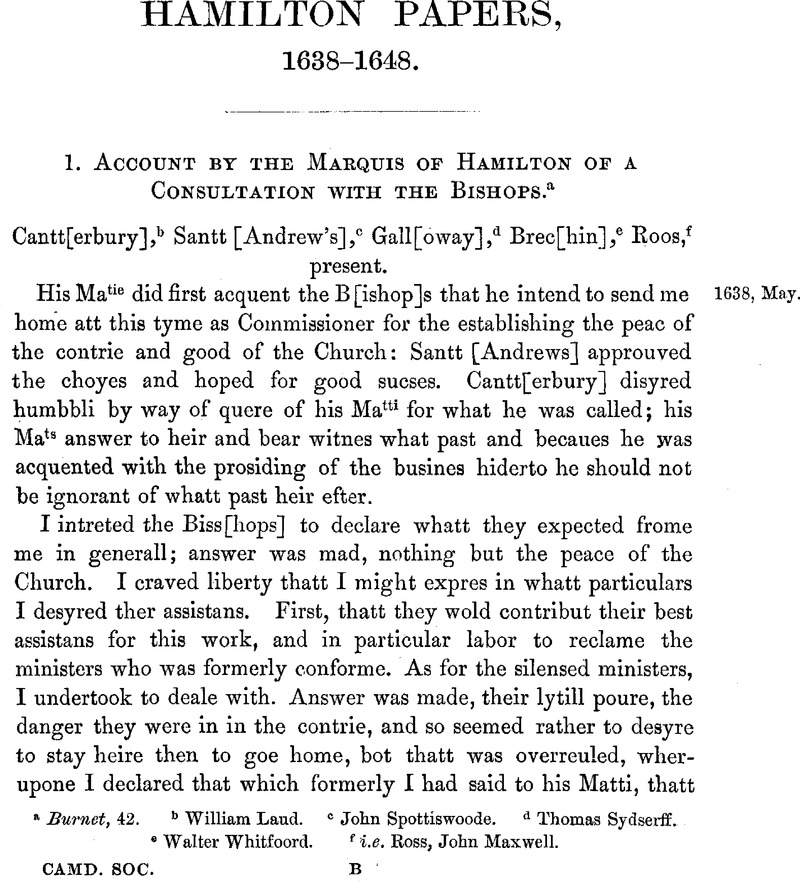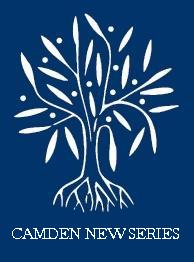No CrossRef data available.
Article contents
Hamilton Papers, 1638–1648
Published online by Cambridge University Press: 24 December 2009
Abstract

- Type
- Hamilton Papers
- Information
- Copyright
- Copyright © Royal Historical Society 1881
References
page 1 note b William Laud.
page 1 note c John Spottiswoode.
page 1 note d Thomas Sydserff.
page 1 note e Walter Whitfoord.
page 1 note f i.e. Ross, John Maxwell.
page 2 note a Printed in Burnet, 43.Google Scholar
page 3 note a To declare the Covenanters traitors if they did not accept of mercy, and deliver up their bands within eight days. Misprinted “five days” in Burnet, 45.Google Scholar
page 3 note b According to Burnet, he arrived at Berwick on June 3. An abstract of this letter is in Burnet, 55. Hamilton's letter from Berwick, referred to by the King on the 11th, Burnet, 55.
page 3 note e His instructions, dated May 16, with queries and explanations, are in Burnet, 46.Google Scholar
page 3 note d Something like “as we expect” is needed.
page 3 note e i.e. the gates.
page 3 note f i.e. failing.
page 4 note a i. e. sign.
page 5 note a See Rothes, ' Relation of Proceedings (Bannatyne Club), 114.Google Scholar
page 5 note b Southesk.
page 5 note c Dalziel.
page 6 note a Answered on the 11th. Burnet, 55.Google Scholar
page 7 note a He arrived at Edinburgh on the day this letter was written.
page 8 note a Sir Thomas Hope.
page 9 note a The word June substituted for May in Charles's hand.
page 9 note b “They,” MS.
page 12 note a i.e. humours.
page 12 note b i.e. world.
page 14 note a There seem to have been one or two letters after this which were seen by Burnet (58, 60), and which are not now at Hamilton Palace.
page 14 note b Answered by the King on June 29, Burnet 61.
page 16 note a i.e. “artillery.”
page 17 note a i.e., sack.
page 17 note b i.e., too weak.
page 17 note c of Ireland.
page 18 note a Abstract given in Burnet, 59.
page 18 note b Sic.
page 19 note a i.e., zeal.
page 19 note b i.e., minute.
page 21 note a Printed in Burnet, 61.Google Scholar
page 21 note b i.e., move.
page 21 note c i.e., suit.
page 21 note d This part abstracted in Burnet, 64.Google Scholar
page 22 note a Written the day after the Marquis's return to Edinburgh, after his first visit to Court.
page 23 note a On August 14, Colonel Alexander Hamilton, the engineer who made the cannon for the army in the following year, wrote to the Marquis on certain charges brought against him by the head of his house, “That I may begin with that which hath least colour of truth—namely, that I should have reported to many ministers and others that your Lp was satisfied with the covenant in your heart—this is so far from any appearance of verity that both yr Lp, and all your friends with whom I spoke in that subject, can witness that it has been my greatest regret to find your Lp so averse and contrary to it as the Bishops themselves could be no more.” He then proceeds to deny that the Marquis knew anything of his manufacture of cannon.
page 23 note b This was written on Hamilton's second return from England bringiug with him the King's covenant. It is abstracted in Burnet, 78.
page 24 note a Answered Sept. 22. Burnet, 79.
page 26 note a Abstracted in Burnet, 79.
page 32 note a Answered Sept. 30. Burnet, 81.Google Scholar
page 33 note a i.e. the want of power.
page 33 note b Sir John Hamilton of Orbieston.
page 35 note a Colonel Alexander Hamilton.
page 35 note b Answered Oct. 2. The date of the King's letter is wrongly giren in Burnet (82) as Oct. 20.
page 36 note a On Oct. 3. the Earl of Haddington wrote to Hamilton from Selkirk that “Traquair was doing all in his power to obtain signatures in the neighbourhood, but there is littill or rather no hope that anybody in this country can be persuadit to subscribe the confession before the assembly.”
A joint letter from Traquair and Haddington written from Selkirk on the same day states that they had appointed that day to make known the King's gracious pleasure to those of that shire, but had found “all both of the ministry and laity resolved in one body to assist the presbytery;” and had therefore thought it best to wait. The ministers were not unsatisfied with the thing itself, “but absolutely refused any present subscription, or to condescend to do it before the assembly.” The gentry answered that they were not acquainted with the King's Covenant, but “that being satisfied in the reality of religion they will never contravert with the Sovereign.”
page 39 note a Answered Oct. 9. Burnet, 84.Google Scholar
page 39 note b Burnet, 81.Google Scholar
page 39 note c Misdated in Burnet, 82.Google Scholar
page 42 note a Perhaps “mad men” or “people” being omitted.
page 42 note b Burnet, 84.Google Scholar
page 45 note a Perhaps this should be “meaning.”
page 50 note a “as my” in MS.
page 52 note a Sir Alexander Gibson of Durie.
page 52 note b Sir George Erskine of Innertiel.
page 52 note c Sir John Scot of Scotstarvet.
page 52 note d Sir John Hope of Craighall.
page 52 note e Sir James Learmonth of Balcomie.
page 52 note f Sir George Auchinlech of Balmanno.
page 53 note a Clydesdale.
page 55 note a See the King's letter of Oct. 29, in Burnet, 88.Google Scholar
page 56 note a This letter is not printed in Burnet.
page 56 note b Dr. Walter Balconqual, called Dean by anticipation. The late Dean, Robert Hunt, died on the 2d Nov.
page 57 note a Burnet, 89.Google Scholar
page 61 note a Hamilton's very remarkable letter of this date printed in the Hardwicke State Papers (ii. 113) is not now at Hamilton Palace.
page 62 note a i.e. in England.
page 62 note b The Earl of Arundel.
page 62 note c Sir Henry Vane.
page 64 note a Illegible from damp.
page 65 note a In England.
page 65 note b Injured by damp, and filled in from conjecture.
page 66 note a Burnet, 107.Google Scholar
page 68 note a Late Governor of Dumbarton Castle.
page 70 note a Copy in Hamilton's hand.
page 72 note a Copy in Hamilton's hand.
page 73 note f Copy, not in Hamilton's hand.
page 76 note b Copy not in Hamilton's hand.
page 76 note c Probably those of April the 18th, 20th, and 23rd. Printed in Burnet, 122, 123Google Scholar. The date of the second is there misprinted as the 10th.
page 77 note a A Scotch expression for “betwixt this and Sunday.”
page 78 note a i.e. sick.
page 78 note b General Ruthven, afterwards Lord Ettrick.
page 78 note c Draft, partly in Hamilton's hand.
page 78 note d Sir Henry Vane.
page 80 note a Burnet, 123Google Scholar, where the date is misprinted as the 10th.
page 80 note a Copy, not in Hamilton's hand.
page 83 note b Copy, in Hamilton's hand.
page 85 note a Copy, not in Hamilton's hand.
page 86 note a Copy, not in Hamilton's hand.
page 87 note a Copy, not in Hamilton's hand.
page 89 note a Copy, not in Hamilton's hand.
page 89 note b Lord Aboyne.
page 89 note c Printed in Burnet 136.Google Scholar
page 89 note d Perhaps “unless.”
page 90 note a Copy, not in Hamilton's hand.
page 93 note a The Duke of Lennox.
page 95 note a i. e. postponed.
page 98 note a Copy.
page 102 note a Wish.
page 102 note b Printed in Napier's Memoirs of Montrose, i. 228.Google Scholar
page 105 note a The Earl of Loudoun.
page 113 note a The Duke had been with the King and had left him dissatisfied.—Burnet, 285–290.
page 115 note a Evidently the one printed in Burnet, 290Google Scholar, under the date of Sept. 26. No doubt Sept. 25 is right.
page 117 note a Doubtless an inclosure in the last, and written before it.
page 118 note a In margin: “Yett trust me not so much as I deserue. L[anerick].”
page 126 note a On a separate sheet.
page 131 note a sic
page 147 note a So decyphered.
page 147 note b Scottish Commissioners.
page 150 note a At Paris.
page 154 note a The first cypher of the word is decyphered “yem,” which makes no sense.
page 157 note a Sic.
page 157 note b Sic.
page 158 note a Sic.
page 158 note b Decyphered “darlye.”
page 158 note c Perhaps an old cypher for “the Duke of Hamilton.”
page 160 note a Sic.
page 160 note b Sic.
page 162 note a Ordered to be printed Feb. 11, 1648.
page 162 note b (Sic) A timeous.
page 165 note a Perhaps “and asked” is omitted.
page 166 note a Sic.
page 166 note b Word undecyphered.
page 167 note a There are some cyphers before “design,” in the end of which is 13 = a. The others were probably blanks.
page 174 note a Wogan.
page 176 note a Sic.
page 176 note b Sic.
page 176 note c i.e. seize.
page 176 note d Sic.
page 178 note a Decyphered “the.”
page 180 note a Perhaps a cypher is mistaken, and the word should be “than.”
page 180 note b Perhaps it should be “the.”
page 183 note a Sic.
page 183 note b Probably “contempt.”
page 186 note a Sic.
page 191 note a Sic.
page 191 note b Query for “be.”
page 192 note a Two cyphers follow, decyphered “Lord Treassurer.”
page 192 note b fully.
page 193 note a Sic.
page 194 note a Something seems omitted here.
page 195 note a Wrongly decyphered “and.”
page 196 note a Sic.
page 198 note a Paper torn.
page 198 note b Query “may” or “might.”
page 198 note c Query “is.”
page 200 note a Sic.
page 201 note a Query Dieppe.
page 201 note b i.e. Captain Batten.
page 201 note c Sic.
page 205 note a On May 17 there was a thanksgiving for “the victory in Wales.”
page 206 note a Decypbered “into.”
page 206 note b Followed by “King,” by mistake.
page 207 note a ? Which may fully be yours.
page 208 note a i.e. Barnard Castle.
page 209 note a i.e. Penrith.
page 211 note a “with” repeated in MS.
page 145 note a Sic.
page 146 note a speedy.
page 146 note b i. e. “eleven.”
page 225 note a Two or three words worn with damp.
page 229 note a i.e. blank.
page 230 note a seriously.
page 231 note a .sic
page 237 note a Elie in Fife.
page 240 note a Autograph signature
page 242 note 1 Autograph signature.
page 243 note a Autograph signature.
page 247 note a i.e. the Kleinscite.
page 248 note a The underlined passages are decyphers.
page 248 note b Possibly “calm.”
page 254 note a William, second Duke of Hamilton.


